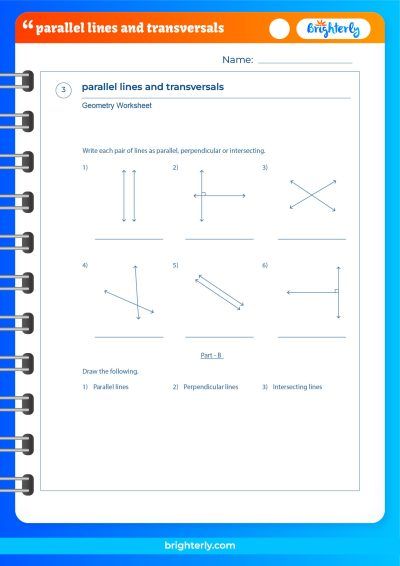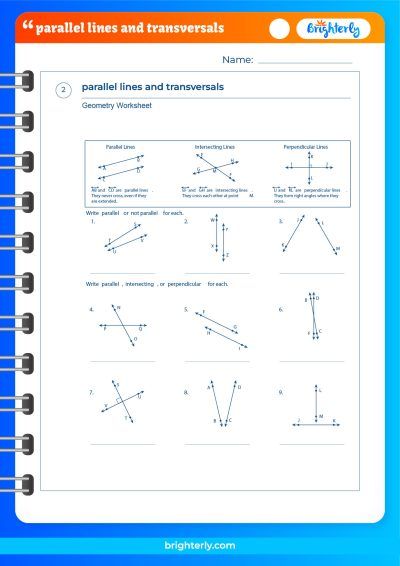Transversal Lines – Definition With Examples
Updated on January 3, 2024
Welcome to the intriguing realm of geometry where we delve into the concept of transversal lines. This article is designed to provide a clear and concise understanding of what transversal lines are, their unique properties, and the various types of angles they form when intersecting with other lines, both parallel and non-parallel. Perfect for students and teachers alike, this piece aims to simplify complex geometric concepts with easy-to-understand examples and explanations.
What Are Transversal Lines?
Transversal lines are a fundamental concept in geometry, crucial for understanding various properties of shapes and angles. A transversal line is a line that passes through two or more other lines in the same plane. These other lines may or may not be parallel. When a transversal intersects other lines, it creates angles, which have specific properties and relationships. Understanding transversal lines helps in comprehending the basics of geometry, including the nature of angles and parallel lines.
Definition of Transversal Lines
A transversal line is defined as a line that intersects two or more lines at distinct points. The key aspect is that the intersecting lines are in the same plane as the transversal. This concept is pivotal in geometry, especially when examining the relationships between angles formed by these intersections. The use of a transversal line creates various types of angles like corresponding angles, alternate interior angles, and alternate exterior angles, which are essential in many geometric proofs and applications.
Examples of Transversal Lines
To understand transversal lines, it’s helpful to visualize real-world examples. Here are a few:
Road Intersections:
Two parallel roads, representing Line A and Line B. A third road that crosses both of these parallel roads acts as a transversal (Line T). The points where this third road intersects the parallel roads are similar to the points of intersection in geometry. This setup is commonly seen in urban grid systems.
Ladder Against a Wall:
Picture a ladder leaning against a wall. The ground and the top of the wall are like two parallel lines. The ladder represents the transversal line. Where the ladder touches the ground and the wall are the points of intersection. This visual helps in understanding the angles formed by transversal lines.
Railroad Tracks and a Crossing:
Consider a railway crossing. The two parallel rails are Line A and Line B, and the road crossing these tracks acts as the transversal (Line T). The points where the road intersects the tracks are points of intersection. This real-life example illustrates how a transversal interacts with parallel lines.
Window Grills:
In a rectangular window grill, the horizontal and vertical bars form a grid of parallel lines. When a diagonal bar (Line T) is added, cutting across the grid, it serves as a transversal. The intersections of the diagonal bar with the horizontal and vertical bars are points of intersection, showcasing how a transversal line crosses parallel lines.
These examples help in visualizing the concept of transversal lines in everyday scenarios. They demonstrate the interaction between the transversal and parallel lines, and the angles formed at the points of intersection.
Properties of Transversal Lines
When a transversal intersects two parallel lines, several angle properties emerge. These include:
- Corresponding angles are equal.
- Alternate interior angles are equal.
- Alternate exterior angles are equal.
- Consecutive interior angles are supplementary.
These properties are used to solve problems involving parallel lines and to prove other geometric theorems.
Angles Formed by Transversal Lines
When a transversal line intersects two or more lines, it creates various types of angles. These include:
- Corresponding Angles: These are on the same side of the transversal and in corresponding positions. For parallel lines, corresponding angles are equal.
- Alternate Interior Angles: These angles are on opposite sides of the transversal and inside the lines intersected. In the case of parallel lines, alternate interior angles are equal.
- Alternate Exterior Angles: These are on opposite sides of the transversal but outside the intersected lines. They are equal when the intersected lines are parallel.
- Consecutive Interior Angles: These angles are on the same side of the transversal and inside the intersected lines. For parallel lines, consecutive interior angles are supplementary (add up to 180 degrees).
Parallel Lines and Transversals
With parallel lines, the transversal creates special angle relationships:
- Corresponding angles are equal.
- Alternate interior angles are equal.
- Alternate exterior angles are equal.
- Consecutive interior angles are supplementary.
These properties are key in geometric proofs and in determining the nature of the lines intersected by the transversal.
| Angle Type | Description in Parallel Lines | Properties in Parallel Lines | Description in Non-Parallel Lines | Properties in Non-Parallel Lines |
|---|---|---|---|---|
| Corresponding Angles | Angles in the same relative position at each intersection | Equal in measure | Angles in the same relative position, but lines are not parallel | Do not have a fixed relationship; vary based on line angles |
| Alternate Interior Angles | Angles inside the lines and on opposite sides of the transversal | Equal in measure | Angles inside the lines, but lines are not parallel | Not equal; their measures depend on the angle of intersection |
| Alternate Exterior Angles | Angles outside the lines and on opposite sides of the transversal | Equal in measure | Angles outside the lines, but lines are not parallel | Not equal; their measures vary with the lines’ orientation |
| Consecutive Interior Angles | Angles inside the lines and on the same side of the transversal | Supplementary (sum to 180°) | Angles inside the lines, but lines are not parallel | Not necessarily supplementary; sum varies with line angles |
| Linear Pair Angles | Angles that form a linear pair (adjacent and supplementary) at each intersection | Supplementary (sum to 180°) | Angles forming a linear pair, but lines are not parallel | Supplementary, as they always form a straight line regardless of parallelism |
| Vertically Opposite Angles | Angles opposite each other at the intersection points | Equal in measure | Angles opposite each other at intersection points | Always equal, as they are vertically opposite regardless of parallelism |
This comprehensive table serves as a quick reference for understanding the different types of angles formed by a transversal intersecting parallel and non-parallel lines. It emphasizes the varied properties of these angles, highlighting the differences in their measures and relationships depending on the parallelism of the intersected lines.
Non-Parallel Lines and Transversals
When intersecting non-parallel lines, the transversal does not create the predictable angle relationships seen with parallel lines. However, the angles formed can still offer important geometric insights:
- The sum of angles around a point is always 360 degrees.
- The sum of angles on a straight line is 180 degrees.
Difference Between Transversal and Other Types of Lines
Transversal lines differ from other types of lines in geometry, such as parallel or perpendicular lines, in terms of their relationships and the angles they form with other lines. A transversal line is unique in that it intersects two or more lines in the same plane, creating a set of angles with specific properties.
Transversal vs Parallel Lines
Transversal lines intersect two or more lines, while parallel lines never intersect. The interaction between a transversal and parallel lines creates equal corresponding angles and equal alternate interior angles, a property not found in other line interactions.
Transversal vs Perpendicular Lines
A perpendicular line intersects another line at a 90-degree angle, while a transversal may intersect at any angle. The relationship between a transversal and perpendicular lines is different from that of parallel lines, as the angles formed do not have the same properties of equality or supplementarity.
Practice Problems on Transversal Lines
- Given two parallel lines intersected by a transversal, find the measure of an unknown angle given the measure of one of the corresponding angles.
- Determine if two lines are parallel, given the measures of angles formed by a transversal.
For better understanding, Brighterly recommends using personalized math worksheets for children. This will allow children to master this topic faster and easier.
Frequently Asked Questions on Transversal Lines
What is a transversal line?
A transversal line is a line that intersects two or more lines at different points in the same plane.
What are the properties of angles formed by a transversal?
The properties include equal corresponding angles, equal alternate interior angles, and supplementary consecutive interior angles when intersecting parallel lines.
How does a transversal line differ from parallel lines?
A transversal intersects other lines, while parallel lines do not intersect each other.






